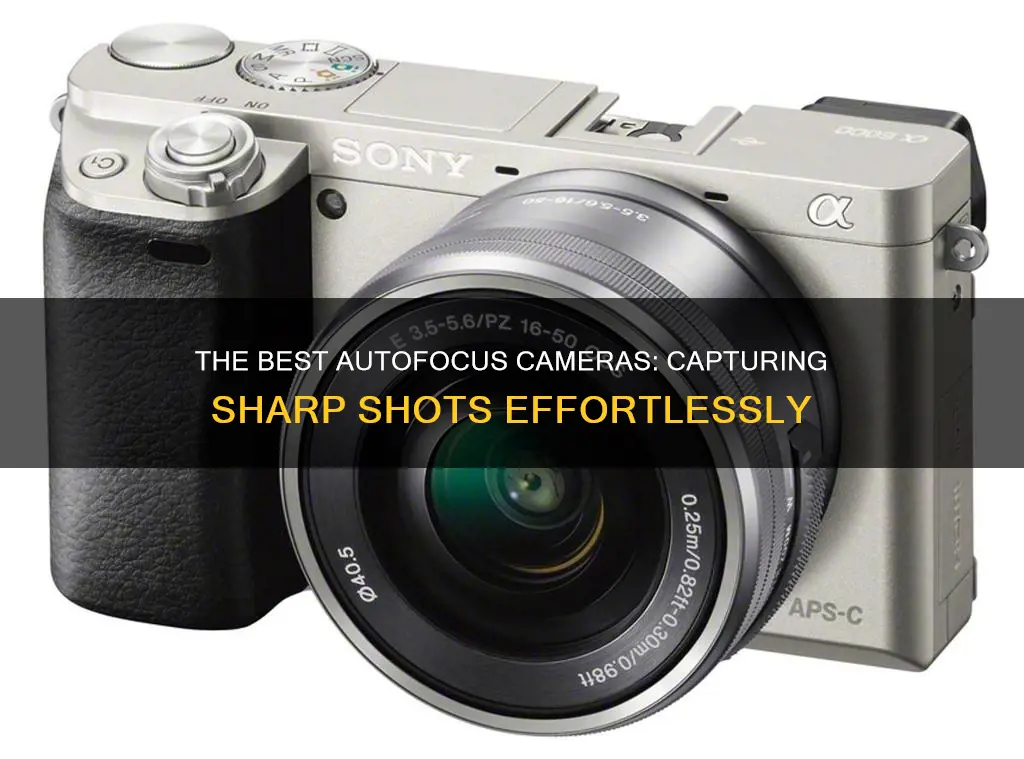
Autofocus is a feature that is now found in most cameras and can make a huge difference when taking photographs. The autofocus feature was first introduced to the mass market in 1977 with the Konica C35 AF camera. Autofocus systems use a combination of sensors, control systems and motors to focus on a subject. There are two types of autofocus systems: phase detection and contrast detection, and two types of autofocus modes: Single AF and Continuous AF. The Sony A9 Mark II, Canon R5C and Nikon Z6 II are among the cameras with the best autofocus features on the market.
| Characteristics | Values |
|---|---|
| Camera Model | Sony A9 Mark II, Canon R5C, Nikon Z6 II |
| Autofocus System | Phase Detection, Contrast Detection |
| Autofocus Modes | Single AF, Continuous AF |
| Camera Type | DSLR, Mirrorless |
What You'll Learn

Single vs. Continuous Autofocus
Single autofocus (AF) and continuous autofocus are two of the autofocus modes available in most cameras. Each mode has its strengths and purposes, and choosing the right one can be the difference between a sharp photo and a missed opportunity.
Single-shot AF or Single AF is best suited for stationary subjects. When you press the shutter button halfway, the autofocus mechanism kicks in. Once the AF algorithms determine that there is something in focus at the selected AF points, the autofocus stops, and the lens stays at that focal distance. You can then release the shutter button to focus again or take the picture. This mode is ideal for posed portraits, a child napping, or a non-sentient subject like a statue.
Continuous AF, on the other hand, is perfect for capturing moving subjects like animals, children, sports events, etc. This mode continuously adjusts the focus to ensure that whatever is in the frame at the given focus point is sharp in the captured image. As long as you hold the shutter button halfway down, the camera and lens keep working to ensure that whatever is in the AF zone is sharp when the shutter is released. This mode is handy for moving subjects, such as runners approaching a finish line, horses trotting across a meadow, or a bird in flight.
While continuous AF is great for capturing moving subjects, it has its limitations. It may struggle to track fast-moving or erratic subjects like a bird or a cheetah chasing prey. To address this, camera manufacturers have developed variations of continuous focus modes, such as Animal Eye AF, Vehicle AF, and Deep Learning AF. Additionally, some cameras allow you to customise how the continuous autofocus behaves in certain situations.
Another consideration when choosing between single and continuous AF is battery life. Continuous AF can drain the camera's battery, especially when used with a large, heavy lens. This may not be much of an issue with DSLRs, which generally have good battery life, but it could be a concern for mirrorless cameras, which tend to have shorter battery lives.
In conclusion, both single and continuous AF have their advantages and use cases. Single AF is ideal for stationary subjects, where you want to lock the focus and ensure it doesn't change. Continuous AF, on the other hand, is designed for capturing moving subjects and will continuously adjust the focus to keep the subject sharp in the frame.
Charging Your Canon Camera Battery via USB: How Long?
You may want to see also

Active vs. Passive Autofocus
There are two types of autofocus (AF) systems: Active and Passive. Each has its own advantages and disadvantages, and understanding their differences can help photographers choose the most suitable system for their needs.
Active Autofocus
The Active AF system calculates the distance between the camera and the subject by emitting a red beam of light towards the subject and then bouncing it back to the camera. This system is beneficial in low-light environments where passive AF struggles. However, it is limited to stationary subjects and only works for close-up shots. Additionally, it may not work through glass or with transparent objects, as the beam reflects off the surface.
Passive Autofocus
On the other hand, the Passive AF system does not rely on emitting a light beam to determine the distance. Instead, it uses either "Phase Detection" or "Contrast Detection" methods (or a combination of both) to detect contrast and achieve accurate autofocus.
Phase Detection AF is commonly found in modern DSLRs and mirrorless cameras. It uses an array of microlenses to split light into a pair of images and measure the distance between them. This method is fast and ideal for tracking fast-moving subjects.
Contrast Detection AF, on the other hand, relies on software algorithms that scan and analyse areas of an image for edge detail. The camera rapidly changes focus from foreground to background until the subject is sharp and in focus. While this method is generally slower, it can be more reliable and accurate in low-light conditions, which is why some cameras combine both Phase and Contrast Detection AF for optimal performance in different environments.
In summary, the choice between Active and Passive AF depends on the specific requirements of the photographer. Active AF is suitable for stationary subjects and low-light conditions but has limitations with moving subjects and range. On the other hand, Passive AF offers more versatility, especially when combined with Contrast Detection, making it a preferred choice for various photography scenarios.
The Emergence of 4K Cameras: A Historical Overview
You may want to see also

Phase Detection vs. Contrast Detection
Autofocus (AF) is a critical feature of modern cameras, allowing photographers to capture sharp images with ease. The two primary autofocus systems used in modern digital cameras are phase detection and contrast detection.
Phase detection autofocus is often found in digital single-lens reflex (DSLR) cameras. In this system, light passes through the lens, hits a reflex mirror, and is reflected through a pentaprism and out through the viewfinder. The centre of the mirror is translucent, allowing some light to be reflected down towards the autofocus (AF) sensor unit. This unit contains sensors that correspond to the camera's AF points. In phase detection autofocus, the light is split into two separate images, and the distance between these images tells the camera how much the lens needs to be adjusted to achieve focus. Phase detection is very fast and ideal for tracking fast-moving subjects. However, it has limitations, such as reduced effectiveness in low-light conditions and with low-contrast subjects. It also requires rigorous calibration and cannot be used in Live View or movie mode.
Contrast detection autofocus, on the other hand, is commonly used in mirrorless cameras. This system works by analysing pixels on the camera's sensor and finding the point of highest contrast, which is assumed to correspond to maximal sharpness. Contrast detection is slower than phase detection as it requires the camera to push the focusing point of the lens back and forth to find the optimal focus point. However, it is highly accurate, especially with still subjects, and there is no need for lens calibration.
Some cameras utilise a hybrid autofocus system, combining both phase and contrast detection methods to achieve the best of both worlds. For example, a DSLR camera may use contrast detection when in Live View or movie mode and phase detection when using the viewfinder. Similarly, some mirrorless cameras employ phase detection AF points in continuous AF mode to improve tracking accuracy.
When choosing between phase detection and contrast detection autofocus systems, it is essential to consider the type of photography you engage in. Phase detection is generally preferred for wildlife or sports photography, where fast-moving subjects need to be tracked. In contrast, contrast detection excels in portrait photography, accurately focusing on critical areas such as the model's eyes.
Leatherette Camera: What's It Really Made Of?
You may want to see also

Autofocus in Video Cameras
Passive AF can be further divided into two types: phase detection and contrast detection. Phase detection autofocus (PDAF) works by dividing the incoming light into pairs of images and comparing them. This method is commonly found in DSLR cameras and provides faster and more accurate focusing compared to contrast detection. Contrast detection autofocus (CDAF), on the other hand, measures the contrast within the sensor field through the lens and adjusts the optical system until maximal contrast is detected. This method is commonly used in mirrorless cameras, point-and-shoot cameras, and smartphone cameras.
Active AF systems, on the other hand, directly measure the distance to the subject, independent of the optical system, and then adjust the focus accordingly. They can use various methods for distance measurement, such as ultrasonic sound waves or infrared light. While active AF systems were more common in early autofocus cameras, they are less prevalent today due to their limitations, such as not being able to focus through windows or on very close subjects.
Some modern autofocus systems combine both active and passive methods, or phase detection and contrast measurement, to improve reliability, accuracy, and speed. This hybrid autofocus system compensates for the weaknesses of individual methods and allows the camera to work in a wider range of conditions.
When choosing a video camera with autofocus, it is essential to consider factors such as the number of autofocus points, the speed and accuracy of the autofocus system, and its performance in different lighting and contrast conditions. Additionally, the type of autofocus system can impact the design of camera lenses, with phase detection requiring lenses that can quickly move their focus point, while contrast detection favours lenses that can sweep through the focal range.
The Evolution of Cameras: Capturing Moments, Freezing Time
You may want to see also

Autofocus for Different Photography Types
Autofocus is a comparatively new invention in the history of photography, first appearing in 1977. It is a useful feature that can help photographers capture sharp images, especially when dealing with fast-moving subjects. However, it is important to understand the different autofocus types and how they can be applied to various photography types.
Landscape Photography
For landscape photography, autofocus may struggle in low-light conditions, so manual focus is often used. When using autofocus, the Single autofocus mode (AF-S) is recommended, as it locks the focus on a static subject. Additionally, the Single-Point AF Area mode can be used to select a single focus point for static elements in the scene.
Wildlife Photography
Wildlife photography often involves capturing fast-moving or unpredictable subjects. For this reason, Continuous autofocus mode (AF-C) is ideal as it tracks the subject even when it moves within the frame. Dynamic AF Area mode is also useful, as it allows the camera to use the selected focus point and surrounding points to keep the subject sharp. Group AF Area mode is another option for capturing a group of animals in a specific area.
Sports Photography
Sports photography requires capturing fast-moving subjects and predicting their movement. Continuous autofocus mode (AF-C) is recommended for this type of photography. Dynamic AF Area mode can be used to track athletes as they move across focusing points. Single-Point AF Area mode can be useful for focusing on a specific athlete.
Portrait Photography
For portrait photography, it is essential to have sharp focus on the subject's eyes. Continuous Eye AF is a useful feature for this purpose. If the camera doesn't have Eye AF, Single AF mode with Single-Point Area can be used to focus on the eyes. Continuous AF with smaller AF Dynamic areas can be used if the subject is moving.
Astrophotography
Astrophotography often involves capturing distant objects in low-light conditions. In such cases, manual focus is typically the best option as autofocus may struggle. Fine-tuning the focus to infinity or a distant object is crucial for achieving sharp images.
Charging Vintage Camera Gear: 1990s Battery Revival
You may want to see also
Frequently asked questions
The Sony A9 Mark II, the Canon R5C, and the Nikon Z6 II are among the best autofocus cameras on the market. Other options include the Fujifilm X-T4, Sony a6600, and the Olympus E-M1 Mark III.
Active autofocus systems use a signal or energy to determine the distance to the subject, such as infrared light or ultrasonic sound waves. Passive autofocus systems, on the other hand, perform an analysis of the image itself to determine the correct focus.
Most modern cameras have autofocus as a standard feature. To test if your camera has autofocus, go outdoors and aim the viewfinder at a clear sky. If you get a "focus okay" indication, your camera has an active autofocus system. If you get a "focus not okay" indication, it has a passive autofocus system.
AF-C stands for Continuous autofocus, which is used for moving subjects. AF-S stands for Single autofocus, which is used for static subjects.
Hybrid autofocus cameras combine two or more autofocus methods, such as active and passive, or phase detection and contrast measurement. This results in increased accuracy, reliability, and speed.







